I am an International Development Studies student at the University of Calgary. I’m currently in my sixth year of my undergraduate degree, unsure of what the heck I was even doing here during my first few years. Although I lacked direction in the beginning, it allowed me to stay open to absorbing new perspectives and I eventually realized that I have a passion for learning and bridging gaps between different worlds and disciplines. As I started growing spiritually in my fourth year, I became very curious about religions and why people believed what they believed. I was full of doubts, as I’m sure most people are throughout their spiritual journey, and so I began attending Bible studies with my Christian friends. I attended for about a year, growing and appreciating the new things I was taught, but still feeling like I had so many unanswered questions. And then I heard about The Kaleidoscope Project, a program offered by the University of Calgary’s Faith & Spirituality Centre. Participants spend a full week learning about and experiencing some of the cultural and religious diversity that our city contains.
To give a little background, I grew up in the Alberta Catholic School System but with atheist/agnostic divorced parents. I was a pretty spiritual kid up until Grade eight, utilizing what little exposure I had to religion (like praying every night before bed, reading the Bible or Bible stories and praying with my rosary). But after an argument about science and God (or the lack thereof) with my father during a family dinner at The Keg Steakhouse, when I didn’t have anything to back my argument up, I eventually gave up and wallowed in defeat. From then up until about 19 or 20 years old, I would have considered myself agnostic.
When I heard about the Kaleidoscope Project, I was instantly intrigued. I signed up for the week-long session to take place in February 2017. Before the program even begins, all participants attend four impactful, emotionally heavy workshops to prepare us for the influx of life-changing experiences ahead of us. We learned about the multiculturalism and diversity found in Canada as well as the discrimination that goes on behind closed doors. We learned about issues such as privilege vs. oppression of different cultural and religious groups, interfaith and interreligious initiatives, respectful dialogue, how to work together despite our differences, and so much more.
And then our Kaleidoscope Project began, and we settled into our accommodation at the FCJ (Faithful Companions of Jesus) Christian Life and Retreat Centre, in downtown Calgary. Each day we learned about a different religion from several different perspectives and denominations, went to one or two different sacred spaces, got exposure to different cultural communities and foods, and participated in case studies, group discussions, reflections, and gratitude circles (which usually ended up getting very emotional). At the end of each day, I summarized some of the highlights and major lessons I learned, and included photos related to the day. And that is what I would like to share with you here – enjoy!
Day One of the Kaleidoscope Project: Today has already been so incredibly heart-warming. Yesterday we went to the Hindu Mandir/temple and met a remarkable person, Usha, who taught us about the beauty of the faith. We engaged in their rituals and prayers, listened to inspiring stories, ate delicious Indian food, and learned that Hinduism is the closest a religion gets to quantum physics.
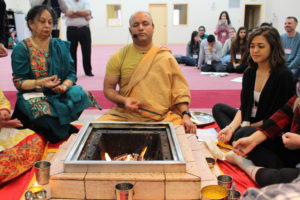 “Hindus believe that no religion teaches the only way to salvation above all others, but that all genuine paths are facets of God’s Light, deserving tolerance and understanding. Hinduism, the world’s oldest religion, has no beginning–it precedes recorded history. It has no human founder. It is a mystical religion, leading the devotee to personally experience the Truth within, finally reaching the pinnacle of consciousness where man and God are one.”
“Hindus believe that no religion teaches the only way to salvation above all others, but that all genuine paths are facets of God’s Light, deserving tolerance and understanding. Hinduism, the world’s oldest religion, has no beginning–it precedes recorded history. It has no human founder. It is a mystical religion, leading the devotee to personally experience the Truth within, finally reaching the pinnacle of consciousness where man and God are one.”
The millions of gods and deities embody the different characteristics of the one God, which they also describe as omniscient, omnipotent, omnipresent and far beyond what our minds could ever comprehend.
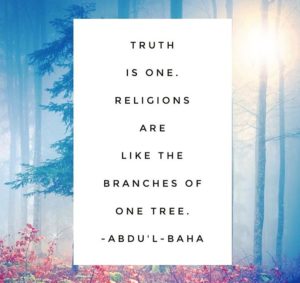 We also learned about the Baha’i faith later in the evening from some love- and light-filled people. It involves a set of beliefs founded on unity and progressive Divine revelations—where human capacity evolves and develops through time (and so must our teachings from God), and where science and religion can be in harmony as two different ways of experiencing truth. These new revelations came to Baha’u’llah, the founder of the religion, in Iran around the 1850’s, in response to mass corruption. The revelations were to prepare humanity for a “Golden Age” and a more unified world, while still recognizing the teachings of all diviners and messengers who came before him (Jesus, Mohammed, Moses, Buddha, Krishna, etc.). The Baha’i faith teaches that there is no room for prejudice and no reservations for love. The goal is unity of humankind, where universal education for all children, and full equality of man and woman, are critical.
We also learned about the Baha’i faith later in the evening from some love- and light-filled people. It involves a set of beliefs founded on unity and progressive Divine revelations—where human capacity evolves and develops through time (and so must our teachings from God), and where science and religion can be in harmony as two different ways of experiencing truth. These new revelations came to Baha’u’llah, the founder of the religion, in Iran around the 1850’s, in response to mass corruption. The revelations were to prepare humanity for a “Golden Age” and a more unified world, while still recognizing the teachings of all diviners and messengers who came before him (Jesus, Mohammed, Moses, Buddha, Krishna, etc.). The Baha’i faith teaches that there is no room for prejudice and no reservations for love. The goal is unity of humankind, where universal education for all children, and full equality of man and woman, are critical.
(Additional note, added later: I never even knew the Baha’i faith existed until that first day of the Kaleidoscope Project. A few months later, the Faith & Spirituality Centre brought in a Baha’i representative whom I approached and talked with for three hours rather accidentally. Ever since then, Sandra and I have been meeting regularly at her home for tea, desserts and scripture studies. She provides me with so much knowledge and spiritual nourishment; she is a role model, mentor, and friend to me. I’ve also been introduced to many people in the Baha’i community who are descendants of those close to Baha’u’llah, The Bab, and Abdu’l-Baha at the time the faith was forming.)
Day Two: Today involved three entirely different perspectives of Christianity from three different denominations. We learned about some of the history of the religion, the divergence and separation of thousands of different belief systems, how its roots come from Judaism, and what the significance of Jesus was/is (somebody who – depending on which denomination you’re from – is God in human form who came to save us and show us the way of love, compassion, unity and divine living in order to get closer to God). We also learned that God is love, and that hell/suffering is the absence of God/love. We gained perspective from 1. A very liberal United Church pastor; 2. A very wonderful Greek Orthodox pastor named Father Peter (orthodox being rooted in the original establishment of Christianity); and 3. We experienced worship music at a Pentecostal church for Tehillah Mondays (which by the way is where young hipsters go to sing, dance and praise Jesus).
Overall, I learned that I know very little about the very religion most of us in the “Western world” grew up around. I learned that, even though many of us have our own perspectives and biases, many leaders of churches still understand that books were made by humans trying to comprehend the incomprehensible. Trying to put words to a Divine Being that is infallible, that is everywhere, in everything and in everyone isn’t possible. Humans are here to experience this temporary world as imperfect souls with free will and an incredibly strong attachment to ego. As Father Peter said, sin comes from ego (Lucifer being the angel that first sinned because he wanted to be greater than God), and sin is what distances us from God (Lucifer and the fallen angels were sent away from God). There are a lot of things that people have told me about Christianity, Catholicism and Hinduism that were incorrect – and the patterns that I’m recognizing right now are the similarities between religions, their values, and their connections throughout history. Yet, we get so attached to our egos trying to justify why all other religions/beliefs are wrong.
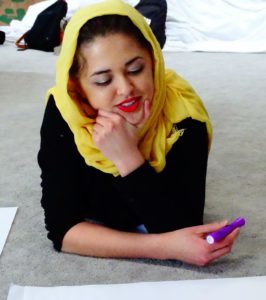
Upstairs at the Sikh Gurdwara, working on a challenging case study about religion in the public sphere.
Day Three: It has been an absolute privilege to engage with the Sikh community today, and to learn from awe-inspiring women leaders, so rooted in their faith, strength, and ambition to be warriors for justice, equality and Divine love. Although the yellow headscarf that I’m wearing in the photo here is simply a head covering to wear out of respect while being in their sacred space, the turbans that men and (some) women wear, I have learned, are meant to symbolize a crown to honour their gurus and the divine wisdom and energy that flows from the crown of the head. It is also worn as a reminder of their faith and responsibility to be a defender for the defenseless (social justice warriors in a sense).
Sikhism teaches a path of Enlightenment and union with the Divine by going inwards. They use symbols, articles of clothing, music/chanting and colours to help remind them of the Divine (infinite bliss, pure love, eternal, all-knowing, ever-forgiving). As described by Dr. Singh (a medical doctor, community leader, and incredibly inspiring woman), white is pure light that encompasses all and increases the electromagnetic field and how we feel. She also shared with us some of the science behind meditation, chanting, prayer and spirituality, and the wondrous healing effects they have on the mind and body (i.e. energetic vibrations that change the brain’s hormonal balance and brings peace to the mind). As well, she explained the significance of hair and head coverings in which hair wrapped around the crown of the head amplifies the electromagnetic energy and sustains the individual at a higher level of consciousness and awareness, which in turn connects us more to the divine.
Day Four: The women who taught us about Buddhism today were phenomenal. Dr. Jackie Ho has a PhD in religious interdisciplinary studies and educated us about what the gods/deities, artifacts and instruments of Buddhism symbolize. She explained the different levels of realms, suffering and enlightenment that our souls can experience (both inside of our minds and after this lifetime), and then guided us in a peaceful meditation.
Dr. Ho also told us her story and how she came to find the Buddhist practice from her Christian background. Afterwards, we went to another temple and met a Dharma Master nun, Jin Zhen Xhu, who made us feel so loved from the light that emitted from her eyes/smile/soul. Her presence was exceptionally comforting. She shared her wisdom with us and told us about the moment she decided to give up her normal “layperson” life to live the monastic life. Buddhism, as was mentioned to us several times, is simply a way of living—ridding our souls of anger, suffering and impurities to learn our karmic lessons, improve our soul’s karma for the next lifetime, and potentially achieve Buddhahood (nirvana, or the highest level of heaven) to escape the cycle of reincarnation. From what I learned, Buddhism is a training of the mind (our “monkey minds”), letting go of attachments, putting aside our egos, embracing suffering to learn from it, and disciplining oneself to achieve enlightenment. The goal is to not get angry.
“If you aren’t at a stage in life where you can’t help someone without getting negative or angry from it, then you’re not ready to help them. You need to help yourself first.”
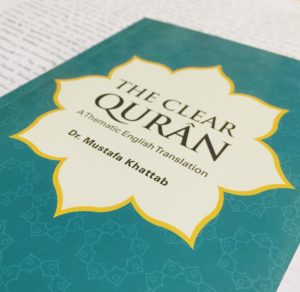 Day Five: Islam. I intended to read a few pages of the Qurân today but accidently ended up reading 160 pages, and much of it was honestly quite beautiful. Islam means submission or surrender (and comes from the root word Salam meaning peace and safety) and being a Muslim means to submit to God and to strive to do good. The Qurân, from what I’ve interpreted, originally sought to correct the path of society in a time of major corruption—to guide those who strayed away from God’s teachings which had come down through Abraham, Moses, Jesus and other prophets. Personally, I found it to be uniting between the previous monotheistic faiths. The Qurân is also refreshing as it bluntly calls people out on their hypocrisy and wrongdoings. Some of the values of this faith that stood out to me (and explained by the Muslim teachers and students during the day) were good character, pure intentions, peace, equality, gratitude, generosity and oneness.
Day Five: Islam. I intended to read a few pages of the Qurân today but accidently ended up reading 160 pages, and much of it was honestly quite beautiful. Islam means submission or surrender (and comes from the root word Salam meaning peace and safety) and being a Muslim means to submit to God and to strive to do good. The Qurân, from what I’ve interpreted, originally sought to correct the path of society in a time of major corruption—to guide those who strayed away from God’s teachings which had come down through Abraham, Moses, Jesus and other prophets. Personally, I found it to be uniting between the previous monotheistic faiths. The Qurân is also refreshing as it bluntly calls people out on their hypocrisy and wrongdoings. Some of the values of this faith that stood out to me (and explained by the Muslim teachers and students during the day) were good character, pure intentions, peace, equality, gratitude, generosity and oneness.
Islam also had an emphasis on education and learning, and there are many scientific references in the Qurân, like the Big Bang and the progression of atoms to molecules to cells to organisms: “Do the disbelievers not realize that the heavens and earth were once one mass then we split them apart? And we created from water every living thing.” [21:30] It also talks about the expansion of the universe: “We built the universe with great might, and We are certainly expanding it.” [51:47].
I also found this beautiful verse about Jesus in the Qurân: “Remember when the angels proclaimed, “O Mary! God gives you good news of a Word from Him; his name will be the Messiah, Jesus, son of Mary; honoured in this world and the hereafter, and he will be one of those nearest to God. And he will speak to people in his infancy and adulthood and will be one of the righteous.” [3:45-46]
I learned some very interesting things about how certain actions during their prayer times are reflections of their Muslim faith. For example, when people pray together at a Mosque, they stand side-by-side, shoulder-to-shoulder, which is meant to show that everyone is equal in the eyes of God. And when they bow down, not only does it show humility and willingness to submit, but, as one girl explained to me, the Devil can fall off your shoulder when you lean forward to bow. And lastly, the five daily prayers are necessary for spiritual nourishment, and serve as reminders to be mindful of God throughout the day.
Day Six: We went to two Jewish synagogues today (Conservative and Reform) and learned so much from two hilariously awesome Rabbis. We heard about the meaning behind Jewish traditions and rituals, and the importance of the Torah (the first five books of the Hebrew bible)—which contains the Laws of God sent down to the Prophet Moses. The theme that I kept getting out of Judaism was “oneness”—that God/Adonai is unity.
Judaism’s sacred Torah Scroll contains the Ten Commandments that were sent to Moses on Mount Sinai after he freed the slaves of Egypt (as the amazing movie Prince of Egypt reminds us). These are the Laws that Christianity and Islam also follow, as well as other religions like Bahá’í. The Jewish Torah is what Christians call their Old Testament.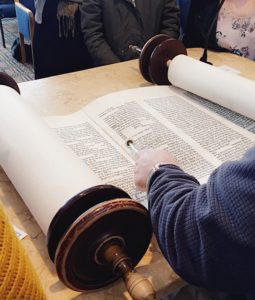
I found this interesting tidbit about the Torah: “The Torah was considered the source of freedom, goodness, and life. Hillel summarized the entire Torah in one sentence: What is hateful to you, do not to your fellow.”
Some of the main values that I was getting from this awesome day of Judaism were unity, family, community, service, contemplation and personal development.
In fact, there was a common theme in the descriptions of God between the different religions we learned about this week, such as infinite, beginning and end, omnipresent, omnipotent, omniscient, unity, cyclical, all-powerful, all-knowing, all-merciful, pure love, light, oneness.
Final Reflections: Although I have been through times of intense resistance and doubts about my spiritual path, and about religion in general, participating in the Kaleidoscope Project has reminded me of the Divine guidance I’ve been receiving throughout my life – and that I simply need to get better at listening to it.
Like a rebellious teenager making the painful transition into adulthood, I am slowly letting go and allowing myself to fall into faith.
Photos by Moneer Alromimah, Héloïse Michaud and Carmen Li.
Visit Carmen Li’s website or view her profile on LinkedIn
Find out more information about The Kaleidoscope Project here.


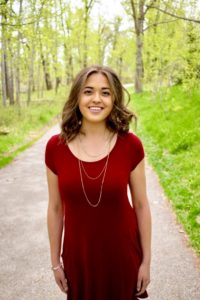
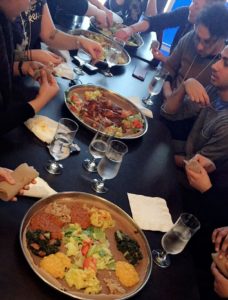
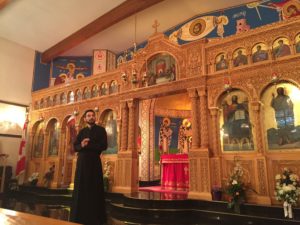
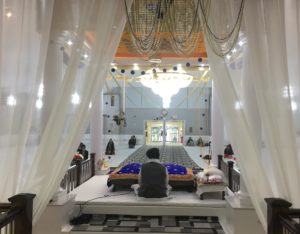
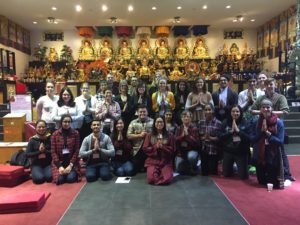
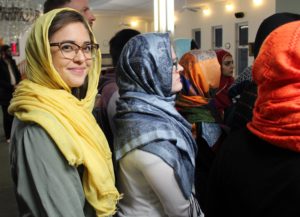
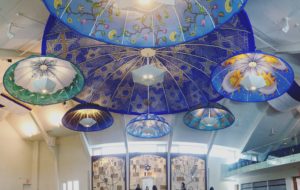






I love this. I went through a phase in my early 20’s where I attended various churches, largely looking for something for my daughter. Some churches I went to once & some
I went to more often but none stuck. This story makes me realize there are more religions to explore. When I was young my daughters friend ended up being her biggest religious influence & I’m grateful because I struggled to find something I could embrace. As a child my parents mostly didn’t go to church or practice religion but when they did it was Church of Christian Science. I probably attended for a total of 9 months in my life? But in my dads later life he became a ‘Reader’ in Calgary: a Reader is sort of like a minister I guess. One Christmas our whole family attended his reading but other than that his reconnection to Church hasn’t really impacted me. Your article reminds me that the closest I have ever came to my own understanding of religion is meditation, kindness, being vegan & reading about quantum physics. This article reminds me I have more to learn. Thank you very much for opening the door of religion a crack once again by sharing your experience here.